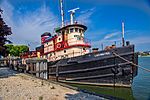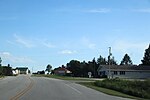Kewaunee River
Bodies of water of Kewaunee County, WisconsinGreen Bay metropolitan area geography stubsRivers of WisconsinWisconsin river stubs
The Kewaunee River is a 27.9-mile-long (44.9 km) river in the U.S. state of Wisconsin. It begins near Frog Station in northwest Kewaunee County and flows southeast to empty into Lake Michigan at the city of Kewaunee. On a yearly basis, the Wisconsin Department of Natural Resources stocks approximately 72,000 Chinook salmon, 132,000 coho salmon, 102,000 steelhead and 54,000 brown trout into the Kewaunee River, hoping to imprint them to the river so that when they mature they return to it and will be captured for egg collection.
Excerpt from the Wikipedia article Kewaunee River (License: CC BY-SA 3.0, Authors).Kewaunee River
Ellis Street,
Geographical coordinates (GPS) Address Nearby Places Show on map
Geographical coordinates (GPS)
| Latitude | Longitude |
|---|---|
| N 44.457777777778 ° | E -87.491111111111 ° |
Address
Ellis Street
Wisconsin, United States
Open on Google Maps









